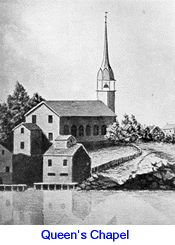|
FRESH STUFF DAILY |
|
|
||
|
|
||
|
|
||
|
SEE ALL SIGNED BOOKS by J. Dennis Robinson click here |
||
Page 2 of 4
Negro Pews in Portsmouth
The Negro Pews here were high above the front door in the upper balcony on the east wall, as far as possible from the pulpit. From 1750-1771 three people were consecutively appointed to oversee or monitor them. Apparently slave owners had to purchase pew space for their slaves in this church, just as they did for themselves. Negro pews were probably a feature of the colonial wooden South Church in the South End, and in Queen's Chapel; they continued into the 1807 brick St. John's Church which replaced it. In St. John's they were identified with brass labels engraved "Negro Pews." Further research will probably reveal the custom of labeled pews at Portsmouth's other early houses of worship in keeping with the general New England custom. Rank, Location, and Meaning In an hierarchical system which expressed "dignity" in terms of proximity to the pulpit the placement of Negro Pews against the back wall of the balcony (in the upper back balcony at North Church) declared black people's status as the lowest order of a hierarchical white society. This is verified in the occasional white reference to these seats by the degrading term "Niger Heaven". A few New England churches placed Negro Pews in the side balconies, an highly-visible location typically reserved for adolescents and unmarried young adults, who were often assigned a monitor to watch their behavior. Placing blacks here gave physical expression to the white perception of black people as childlike, untrustworthy, or given to inappropriate behavior. This attitude became an enduring fixture of white culture. It was expressed as recently as the mid-20th-century when the term "boy" was used to exclude grown black, gay or Jewish men from mainstream culture or imply their place at the bottom of society among children. Free Seats, Negro Pews, and Cultural Ambivalence From the 1840s to the 1930s New England churches gradually shifted from private pews to free and open seating, giving rise to the term "free church". Old pew numbers and labels were usually left in place. This transition occurred in a society that was increasingly democratic in its outlook toward white people, but remained racially segregated. The adoption of free seating must have placed black Americans in an ambivalent social position, especially where old "Negro" labels remained in place. CONTINUE Black Worship, White Status Please visit these SeacoastNH.com ad partners.
News about Portsmouth from Fosters.com |
| Friday, April 26, 2024 |


|
Copyright ® 1996-2020 SeacoastNH.com. All rights reserved. Privacy Statement
Site maintained by ad-cetera graphics

 Stories
Stories



 Portsmouth was no exception to this regional custom. Negro Pews were features of the old North Meetinghouse, which stood on Market Square from 1711 to 1854. This wooden church was three stories high with two balconies. Its main door was on its broad side opening onto Pleasant Street. The pulpit was on the opposite broad side, backing up to Church Street.
Portsmouth was no exception to this regional custom. Negro Pews were features of the old North Meetinghouse, which stood on Market Square from 1711 to 1854. This wooden church was three stories high with two balconies. Its main door was on its broad side opening onto Pleasant Street. The pulpit was on the opposite broad side, backing up to Church Street.














